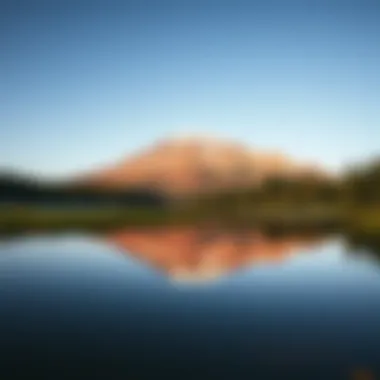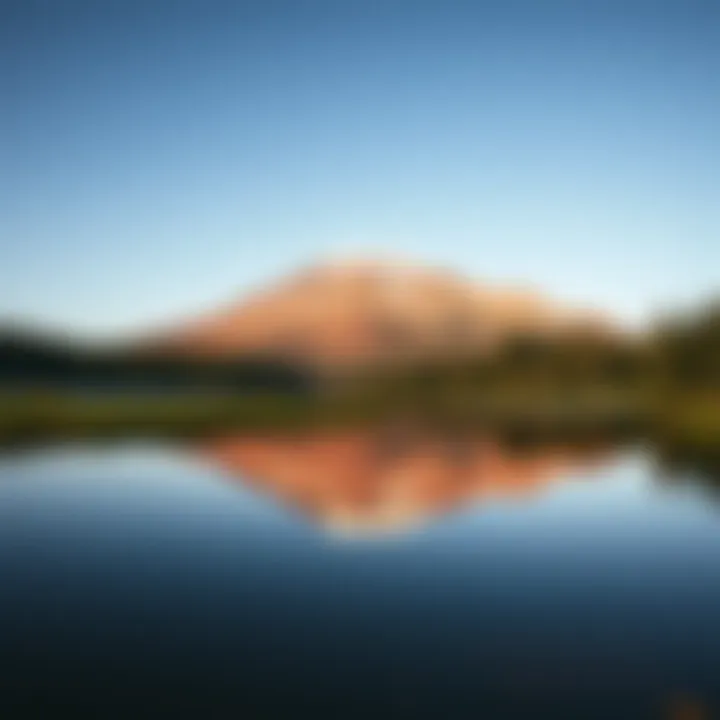Guidelines for Visiting Mt. Hood: A Comprehensive Exploration


Intro
Visiting Mt. Hood is not just a journey through breathtaking landscapes; it is an immersion into a rich tapestry of forest ecology and biodiversity. Understanding the unique environmental aspects that shape this magnificent mountain can help visitors appreciate and engage with their surroundings more thoughtfully. When planning your adventure, there are several guidelines that can enhance your experience while ensuring that the natural beauty remains preserved for future generations.
Through this article, we will explore essential components of visiting Mt. Hood, from the significance of forest ecosystems to community engagement and sustainable practices. Embarking on this kind of exploration fosters a deeper connection with nature and the surrounding communities, enhancing the overall experience of one of Oregon's most iconic sites.
Forest Ecology and Biodiversity
Importance of Forest Ecosystems
Forests serve as the lungs of our planet, providing oxygen, storing carbon dioxide, and acting as critical habitats for countless species. The woodlands surrounding Mt. Hood encapsulate this truth perfectly. They are not simply a backdrop for recreational activities; they are vital systems that sustain life in various forms. These ecosystems stabilize local climates, regulate water cycles, and support diverse flora and fauna. Understanding these dynamics allows visitors to appreciate the role of Mt. Hood's forests in the larger context of environmental health. Additionally, they demonstrate the delicate balance of life and the impact of human activities.
Flora and Fauna in Woodlands
The base of Mt. Hood is adorned with a variety of trees, including Douglas firs, western hemlocks, and lodgepole pines. In spring, one might stumble upon vibrant carpets of wildflowers like lupines and columbines, which create an exquisite sight against the mountain's rugged backdrop. Animal enthusiasts will find no shortage of wildlife, from black bears to shy deer, and a multitude of avian species, including the mesmerizing spotted owl.
"Nature always wears the colors of the spirit." – Ralph Waldo Emerson
This rich biodiversity is a reminder that every element of this ecosystem plays a specific role. For example, certain insects promote pollination processes essential for plant reproduction. Understanding these relationships not only enhances your visit to Mt. Hood but also reinforces the importance of conserving these habitats.
Sustainable Forestry Practices
Techniques for Responsible Management
To ensure that the beauty of Mt. Hood is preserved for generations to come, sustainable forestry practices are crucial. Different methods, such as selective logging and reduced-impact techniques, have been implemented to minimize ecological disturbance. These techniques allow for forest regeneration while maintaining healthy habitats for wildlife.
Certification Schemes and Standards
Engaging in responsible tourism also extends to awareness of certification schemes like the Forest Stewardship Council (FSC) and Sustainable Forestry Initiative (SFI). These organizations set rigorous standards for environmentally, socially, and economically sustainable forest management. When purchasing wood products or engaging with local businesses, looking for these certifications can help promote and support responsible breeding and harvesting practices.
Community Engagement and Stewardship
Role of Local Communities
Local communities play a pivotal role in the stewardship of Mt. Hood. They not only provide valuable insights through their traditions and knowledge of the land but also work tirelessly to maintain its natural beauty. Engaging with these communities allows visitors to gain a deeper understanding of the cultural significance of the mountain, instilling a sense of respect and responsibility in every traveler.
Volunteer Opportunities for Engagement
For those looking to go a step further, several organizations offer volunteer opportunities to contribute to the conservation efforts of Mt. Hood. From trail maintenance to participating in reforestation projects, these experiences can yield a rewarding connection to the land while fostering community ties and environmental stewardship.
For more information on community engagement initiatives, consider visiting Oregon.gov.
By visiting Mt. Hood with awareness and a commitment to responsible practices, travelers can ensure their experience is enriching, supporting the preservation and appreciation of this ecological wonder.
Preparing for Your Visit
Visiting Mt. Hood isn't just a casual trip; it’s an experience rich with natural beauty and exploration. To make the most of your time in one of the Pacific Northwest's crown jewels, preparing for your visit is not only advisable, it’s essential. Preparation can mean the difference between a memorable adventure and a visit that falls flat due to missed opportunities or unexpected challenges. This section lays the groundwork for an enriching experience.
Researching the Area
Before you lace up your hiking boots, it’s vital to do a bit of homework on Mt. Hood and its surroundings. Understanding the geography, weather patterns, and seasonal changes can greatly enhance your visit. The mountain itself, towering at 11,240 feet, hosts several ecosystems, each charming its own unique flora and fauna. For instance, knowing that the west side tends to be wetter and more lush compared to the drier eastern slopes can help tailor your hiking routes or photography spots.
Look into the nearby towns as well. Government Camp and Hood River, for instance, offer essential amenities, local eateries, and historical insights that enrich the Mt. Hood experience. Researching trail conditions is also crucial. Websites like the U.S. Forest Service’s site (fs.usda.gov) provide real-time updates on trail closures and conditions. To sum it up, doing your homework ensures you're not just a visitor, but a well-informed traveler ready to embrace the mountain's offerings.
Understanding Accessibility
Navigating Mt. Hood requires a certain degree of understanding regarding accessibility. Not everyone can tackle challenging trails or snowy peaks, and that’s perfectly fine. With various options available for all ability levels, it’s essential to know what suits you or your group's needs. For instance, some scenic lookout points are easily reachable by paved paths that even families with young children can enjoy.
Consider public transportation options if you’re not driving. The Columbia Gorge Express provides hassle-free access from Portland, which can be a game-changer, particularly during peak tourist seasons. For those with mobility impairments, be sure to familiarize yourself with ADA-compliant trails and facilities. Knowing the ins and outs of accessibility not only enhances your enjoyment but also promotes a more inclusive atmosphere for all visitors.
Gathering Necessary Equipment
Packing for a journey to Mt. Hood means more than tossing a few snacks into a backpack. Weather can swing from sunny to snowy in the blink of an eye, so coming prepared is key. Essentials like layered clothing, waterproof shoes, and sturdy hiking poles can make or break your comfort while navigating the trails.
Make sure to include the following items:
- Hydration pack or water bottles: Dehydration is a sneaky adversary, especially at higher elevations.
- Snacks and energy bars: The right fuel keeps your energy levels up during those vigorous hikes.
- First-aid kit: Always be prepared for minor scrapes or blisters.
- Navigation tools: A physical map or a reliable GPS app ensures you won’t lose your way.
Additionally, if you plan on capturing the stunning views, don’t forget your camera or smartphone – Mt. Hood boasts some of the most picturesque landscapes in the United States. Being well-prepared equips you to savor the best that this majestic mountain has to offer.
Travel Routes to Mt. Hood
Visiting Mt. Hood is not just a journey to a majestic peak, but a venture that involves strategic planning regarding how to get there. The right travel route can make a profound difference in your overall experience. Whether you opt for a leisurely drive, rely on public transportation, or seek out scenic pathways, each option presents unique benefits and considerations.
By Car
For many, driving is the favored method to reach Mt. Hood. This approach offers the flexibility to stop at various points of interest along the way. The Interstate 84 provides a straightforward path to the mountain, leading to stunning views of the Columbia River Gorge. Not to forget, the drive along the Mt. Hood Scenic Byway is nothing short of spectacular, weaving through lush forests and quaint towns. Keep an eye out for roadside fruit stands or local coffee shops; they add flavor to the journey.
When planning your drive, it’s wise to check the road conditions, especially in winter. The area may experience snow and ice, posing challenges that are not always easy to navigate. Keeping essentials in your vehicle, like tire chains, a first-aid kit, and warm blankets is advisable. This ensures safety and preparedness for any unforeseen situations.
Public Transportation Options
For those who prefer not to drive, various public transit routes offer access to Mt. Hood. The Mt. Hood Express, a reliable bus service, connects major towns to key attractions around the mountain. This option minimizes the hassle of parking and allows you to sit back and enjoy the scenery without focusing on the road. Plus, it can be a cost-effective method for travelers.


However, it’s important to note that public transport schedules can vary seasonally. Researching the most updated routes and timings ahead of your trip is crucial. Also, be prepared for possible delays and plan accordingly to ensure you make the most of your time at Mt. Hood.
Scenic Routes
Taking a scenic route to Mt. Hood is a journey in itself. The winding roads through the forests, rivers, and small communities present a chance to appreciate the natural beauty of Oregon. The Historic Columbia River Highway, renowned for its breathtaking views, leads you to various waterfalls, including the iconic Multnomah Falls. Along the way, there are numerous viewpoints where you can pause and soak in the surroundings.
Another beautiful option is the Cascade Lakes Scenic Byway. As you meander through this route, expect gorgeous views punctuated by sparkling lakes and towering mountains. During spring and summer, vibrant wildflowers dazzle along the roadside, creating a picturesque landscape hard to forget.
"Embarking on a scenic route to Mt. Hood is like painting with nature's colors, offering a varied palette of landscapes and experiences."
Choosing the right route to Mt. Hood can significantly enhance the experience of this natural wonder. Each travel option reflects unique traits and rewards, allowing visitors to engage with the region’s breathtaking scenery and rich culture, making the journey as memorable as the destination itself.
Accommodations Near Mt. Hood
Choosing the right place to stay while visiting Mount Hood significantly enhances the experience and allows travelers to immerse themselves in the stunning nature that surrounds the area. With various options ranging from luxurious hotels to rustic cabins, understanding accommodations can help guests find their perfect fit based on convenience, comfort, and the types of adventures they plan to engage in. When selecting accommodation, one must consider proximity to activities, amenities available, and the overall ambiance, impacting the enjoyment of this majestic mountain.
Hotels and Lodges
When it comes to hotels and lodges near Mount Hood, guests are often spoiled for choice. Many of these establishments provide comfortable lodging along with necessary amenities like Wi-Fi, dining options, and sometimes even spa services after a long day exploring the outdoors. Notably, Timberline Lodge, a national historic landmark, offers visitors a blend of history and modern comfort. The stunning architecture and breathtaking views really take the cake.
These hotels tend to be located in key areas close to hiking trails and ski resorts, making them convenient for those looking to enjoy a variety of seasonal activities. Some properties even provide shuttle services that connect you to different hiking trails or ski lifts, which is a bonus for those not wanting to bother with the car.
"The comfort of a warm bed after a day of hiking is unmatched!"
In addition to the warmth and hospitality, many lodges offer packages that might include lift tickets, dining vouchers, and even guided tours, presenting a compelling option for those who want to simplify their planning.
Campgrounds
For a more rustic experience, the campgrounds around Mount Hood provide a true back-to-nature vibe. Whether one prefers tent camping or opting for RV sites, establishments like Timothy Lake Campground offer ample opportunities to connect with nature. Open during the warmer months, these campgrounds allow guests to pitch tent under a starry sky, surrounded by the dazzling forest and the sounds of nature.
Before setting out, it's prudent to check for reserved spots, as popular sites can fill up quickly during peak seasons. Camping not only provides a more immersive experience but also enables opportunities for campfires, storytelling, and bonding with others who share a love for the great outdoors. Remember, it’s essential to follow all rules and guidelines when it comes to open flames and waste disposal to preserve the beauty of the areas.
Cabin Rentals
For those seeking a middle ground between hotels and campgrounds, cabin rentals have become increasingly popular. Places like Collins Lake Resort provide fully-equipped cabins, allowing guests to enjoy the comfort of home while still being steeped in the natural ambiance of Mount Hood. These properties often come with kitchens, making it easy to whip up a hearty breakfast before heading out for a day of adventure.
Renting a cabin can be particularly beneficial for groups or families, offering communal spaces that foster socializing and togetherness. Some cabins also feature hot tubs on the deck, allowing visitors to unwind while soaking in stunning views of the mountainous landscape. It’s an ideal way to capitalize on the charm of the mountain while still having access to modern conveniences.
Exploring Seasonal Activities
Engaging with Mt. Hood through its diverse seasonal offerings provides visitors a unique opportunity to connect with nature in various ways. Each season casts a different hue on the landscape, inviting distinct adventures and experiences. When planning your visit, considering what seasonal activities are available is essential not only for enjoyment but also for immersing oneself in the region's robust ecosystem. Seasonal changes affect wildlife behavior, plant life, and weather conditions—all of which enrich your overall experience at this iconic location.
Summer Adventures
Summer at Mt. Hood is a vibrant tapestry of activities, where long daylight hours beckon outdoor enthusiasts to come out and play. Hiking trails, like the well-known Timberline Trail, offer a spectacular way to witness the lush greenery and breathtaking views. On the other side of the coin, water sports at nearby lakes such as Trillium Lake provide a refreshing respite from the heat. Fishing, kayaking, or simply lounging by the water can be a great way to spend a hot afternoon.
Moreover, summer is the prime time for mountain biking. The numerous trails around the area cater to varying skill levels and provide a thrilling way to explore the mountainous terrain.**
Winter Sports
As temperatures drop and snow blankets Mt. Hood, it transforms into a winter playground. Skiing and snowboarding are the stars here, with resorts like Timberline Lodge and Mt. Hood Meadows offering runs for all skill levels. Beyond the slopes, snowshoeing has gained popularity, allowing travelers to traverse untouched snowfields.
The area’s reputation for snowfall means quality conditions almost every winter, and these activities promote a connection with the mountain's rugged beauty. Remember to check local conditions and advisories for the best experience. Safety gear is also a must—make sure to be well-prepared before attempting any winter sports.
Fall Foliage Viewing
As summer wanes, Mt. Hood bursts into a symphony of colors. Fall foliage viewing is nothing short of spectacular, particularly in areas like Government Camp. The changing leaves create a vivid contrast against the evergreen backdrop, drawing visitors with cameras and tranquil spirits. Taking a scenic drive along the Hood River Highway offers breathtaking vistas of vibrant autumn leaves mixed with the snow-capped peak.
For those who appreciate the beauty of this season, it’s an excellent time for photography. Arranging sunset shoots can yield some stunning images that capture the rich palette of fall.
Wildflower Hikes in Spring
Spring ushers in a burst of life with wildflower blooms covering the meadows. Popular hikes during this season include the popular Ramona Falls Trail, where vibrant flowers dot the landscape as they emerge from winter’s slumber.
Events like the annual Wildflower Festival at the nursery nearby showcase not only the flora but also the interconnectedness of wildlife and plant life in the region. These outings not only promote physical activity but also an awareness of the importance of conservation efforts as we enjoy nature's offerings.
Each seasonal adventure at Mt. Hood adds a layer to your understanding of the area’s ecology and beauty. Whether you visit in summer, winter, fall, or spring, you'll find unique opportunities to engage deeply with this remarkable landscape.
Environmental Considerations
When exploring Mt. Hood, a careful approach to the environment is essential. This iconic natural feature isn't just a beautiful backdrop; it is a delicate ecosystem that requires our respect and protection. Understanding environmental considerations ensures that visitors can enjoy this majestic area while minimizing their impact. From adhering to sustainability practices to being informed about wildlife and plant life, these aspects play a vital role in preserving the natural beauty of Mt. Hood for future generations.
Leave No Trace Principles
Embracing the Leave No Trace principles is foundational for anyone visiting natural spaces like Mt. Hood. These guidelines not only promote responsible outdoor activities but also safeguard the wilderness. Here are the essential principles:
- Plan Ahead and Prepare: Research conditions and regulations, ensuring a safe and responsible visit.
- Travel and Camp on Durable Surfaces: Stick to existing trails and campsites to prevent soil erosion and protect fragile habitats.
- Dispose of Waste Properly: Always pack out what you bring in. This includes food scraps, personal items, and any other bits that could harm the environment.
- Leave What You Find: Preserve the natural and cultural features. This means no picking flowers or disturbing rock formations.
- Minimize Campfire Impact: Use a camp stove instead of making a fire in the wilderness where it could affect the ecosystem.
- Respect Wildlife: Observe animals from a distance, keeping food secured and minimizing disturbances.
- Be Considerate of Other Visitors: Maintain quiet to preserve the natural sounds of the area and adhere to regulations.
These principles create a framework for responsible tourism, allowing visitors to enjoy Mt. Hood without detriment to its natural state.
Wildlife Protection
The wildlife around Mt. Hood is both diverse and fragile. Many species are integral to the local ecosystem, and their protection is critical. As a visitor, being aware of wildlife protection measures is paramount. For instance:
- Stay on Designated Trails: This reduces the chances of disturbing animal habitats.
- Observe Instead of Interacting: Use binoculars or telephoto lenses for wildlife watching; approaching animals can stress them and disrupt their natural behaviors.
- Report Poaching or Disturbances: If you notice illegal activities or harmful behaviors, report them to local authorities.


By following these steps, visitors contribute to the health of local wildlife populations, ensuring they thrive alongside human activities.
Plant Life Conservation
Flora on Mt. Hood isn't just scenery; it's a vital part of the ecosystem. Protecting plant life means preserving the habitat for numerous animal species and maintaining the natural beauty visitors come to enjoy. Here’s how to contribute to plant life conservation:
- Stay on Trails: Walking off established paths can trample delicate vegetation.
- Avoid Picking Plants: Whether it be wildflowers or other native plants, picking them can disrupt the ecosystem and diminish the scenery for others.
- Educate Yourself on Native Species: Understanding what to look for enhances your appreciation and ability to protect these plants.
Being mindful of plant life ensures a rich environment for future visitors and wildlife alike. Amidst the towering pines and blooming wildflowers, let’s be stewards of this remarkable landscape.
Preserving Mt. Hood's natural beauty is not just a personal choice; it’s a collective responsibility we all share.
Cultural Significance of Mt. Hood
When pondering the resounding presence of Mt. Hood, one often overlooks the depths of its cultural significance. This mountain is more than just a picturesque elevation; it embodies a rich tapestry of history, tradition, and communal identity. For local communities and visitors alike, understanding the cultural aspects can enrich the experience, weaving together the threads of the mountain’s past and present.
Historical Context
To grasp why Mt. Hood holds a special place in the hearts of many, one must first delve into its historical context. The mountain has long stood as a beacon of inspiration and a focal point of countless stories.
- Early Exploration: European settlers first encountered the mountain in the early 1800s, with significant expeditions led by men like John C. Frémont. These explorations spurred an allure that lured adventurers and settlers to its slopes. Yet, before these encounters, indigenous populations had cultivated a profound connection with the land that deserves recognition.
- Agriculture and Trade: The rich volcanic soils surrounding Mt. Hood led to fruitful agricultural endeavors, driven by those who understood its cycles. This resulted in a vibrant trade network, with communities thriving in harmony with nature.
The mountain also inspired art and literature, embedding itself in the collective consciousness of those who sought its majesty. Many literary works and artistic interpretations showcase its timeless beauty and cultural identity. Through these narratives, a deeper appreciation of nature is cultivated, inviting respect and stewardship.
Indigenous Communities
Focusing on indigenous communities, we see an intricate relationship that has developed over millennia. The Multnomah, Wasco, and other tribes have rich oral histories associated with Mt. Hood.
- Cultural Practices: For these communities, the mountain is more than an object of scenic beauty; it’s imbued with spiritual significance. Traditions and ceremonies often pivot around the seasonal changes of Mt. Hood. Events like the First Salmon Ceremony involve celebrating the bounty of nature while honoring its sacredness.
- Land Stewardship: Indigenous knowledge systems have long emphasized sustainable practices, recognizing their role as stewards of the environment. This ancient wisdom offers valuable lessons for modern conservation efforts, merging age-old techniques with contemporary strategies. These practices are crucial in teaching visitors how to interact positively with the land.
"Mt. Hood is not just a mountain; it’s a story, a keeper of wisdom through generations."
Visitors to Mt. Hood are encouraged to engage with these local narratives, gaining insights that elevate their experience from mere sightseeing to a journey of understanding and respect. Discussions on land rights and recognition for indigenous communities further underscore the mountain’s role as a connector of peoples and perspectives.
By diving into the cultural significance of Mt. Hood and acknowledging the historical narratives as well as the enduring presence of indigenous communities, travelers can cultivate a richer, more respectful relationship with this iconic natural landmark. The mountain speaks to the importance of listening—not just to its serene vistas, but to the stories and traditions that flow from it.
Health and Safety Tips
When planning a trip to Mt. Hood, understanding health and safety tips is crucial for ensuring an enjoyable experience. The mountain's diverse environment can present various challenges, from fluctuating weather conditions to the physical demands of outdoor activities. By equipping yourself with the right knowledge and preparation, you can mitigate risks and make the most of your adventure.
Weather Preparedness
Weather at Mt. Hood can change faster than you can say "What’s the forecast?" Starting your day under bright blue skies may turn into a downpour by noon, or worse, unexpectedly cold weather. Always check the local weather reports and advisories before heading out. Equip yourself with clothing layers, and waterproof gear. Here’s a quick checklist of items to pack for varying conditions:
- Waterproof jacket: To keep you dry in case of showers.
- Insulated layers: To maintain warmth when temperatures dip.
- Appropriate footwear: Waterproof hiking boots can make a world of difference.
Also, consider keeping an eye on weather apps like NOAA Weather or Weather Underground, which provide reliable and real-time forecasting. Knowledge of the potential for snow, fog, or storms can help you adjust your plans. In short, being ready for the unexpected can be the difference between a successful excursion and a day you'd rather forget.
Physical Fitness for Activities
Mt. Hood is not just a pretty postcard; it’s also a great place to get your blood pumping. Whether you're a casual hiker or a seasoned climber, being in shape enables you to enjoy all that the mountain has to offer. Physical fitness helps you handle tough terrains and higher altitudes with more ease. Here are some aspects to consider for getting fit for your visit:
- Cardiovascular endurance: Activities like jogging or cycling help build up stamina for those long trails.
- Strength training: Focus on your legs and core through bodyweight exercises or weightlifting. Squats and lunges will give you the strength to tackle steep inclines.
- Flexibility: Regular stretching can help prevent injuries, making your hikes more comfortable and enjoyable.
For those who may be new to hiking or climbing, consider starting with shorter trails and gradually increasing the difficulty. Making physical activity a part of your routine not only prepares your body for the demands of the mountain but also enriches your overall experience.
"The best way to prepare for adventure is not just in planning but also in physical readiness—every step counts towards a memorable journey."
Overall, focusing on health and safety when visiting Mt. Hood ensures you're not just an observer of its beauty, but an active participant in all its adventures.
The Summit Experience
Reaching the summit of Mt. Hood is not just a trek; it’s a rite of passage for many adventurers and nature enthusiasts. The experience offers a blend of physical challenge, breathtaking views, and a profound connection with the natural world. For those who seek to understand what makes this mountain special, it’s clear: the summit provides an unparalleled perspective—not just of the landscape, but of one’s own limits and capabilities.
The Climbing Challenge
Climbing to the top of Mt. Hood is no small feat. The ascent typically requires a sturdy level of fitness, climbing skills, and a willingness to navigate variable conditions that can change in a heartbeat. Participants must also be ready for steep slopes, crevasses, and, of course, the altitude that presents its own kind of test.
Notably, the climbing season typically runs from late spring to early summer. During this window, the conditions can be more favorable, though this is also when many climbers flock to the area. Here are some critical considerations:
- Preparation: Engaging in a solid training plan is essential. Climbers should develop cardiovascular strength through hiking, running, or cycling and include strength training focusing on legs, core, and upper body.
- Equipment: Proper gear can make or break the experience. Essential equipment includes crampons, ice axes, and appropriate layers of clothing to handle unpredictable weather conditions.
- Guidance: For first-timers, going with an experienced group or hiring a certified guide can enhance safety and provide valuable insights into climbing techniques and mountain awareness.
"Climbing is not just about reaching the summit; it's about overcoming challenges and experiencing the journey—every step counts."
Guided Tours
For those who prefer a structured approach or feel uncertain about their climbing abilities, guided tours represent a viable option. Many reputable guiding companies operate around the Mt. Hood area, offering various packages to suit different skill levels. Choosing this route means not only safety in numbers but also insightful leadership provided by seasoned climbers.
Guided tours typically include:
- Safety Briefing: Guides take the time to brief climbers on safety protocols, equipment usage, and route planning.
- Skill Development: For less experienced climbers, guided tours often incorporate skill training sessions focused on climbing techniques and wilderness safety.
- Comprehensive Schedule: Typically structured to maximize the experience, these tours might include acclimatization days to ensure climbers are well-prepared for the ascent.
In summation, whether you tackle the summit independently or through a guided tour, the journey offers physical challenges that cater to both your adventurous spirit and your desire to explore nature. Preparing adequately and choosing the right approach can greatly enhance the experience, allowing everyone, from novices to veterans, to bask in the transformative power of Mt. Hood's summit.


Photography and Observation
Photography and observation go hand in hand when it comes to experiencing the breathtaking beauty of Mt. Hood. Capturing the essence of this majestic mountain requires a keen eye and a respect for the surrounding landscape. In the context of Mt. Hood, photography serves not only as a means of documentation but also a way to share the natural splendor and biodiversity with others. When you set out to photograph Mt. Hood, you're not just taking a picture; you're preserving a moment in time, showcasing the interplay of light, shadow, and the vivid colors that change with the seasons.
We must also consider that photography at Mt. Hood isn’t merely about pretty landscapes. Elevating one's awareness of the environment contributes to more mindful travel practices, promoting a culture where we appreciate but also protect our natural habitats. So, make sure your camera is ready, and take time to simply observe the intricate details that the naked eye might miss. After all, every snapshot tells a story.
Ideal Photography Locations
When planning your photography expedition, knowing the best locations is key. Mt. Hood provides a plethora of breathtaking backdrops for capturing memorable images. Here are some prime spots:
- Trillium Lake: With a panoramic view of Mt. Hood reflected in its waters, Trillium Lake is a crowd-favorite for photographers, especially at sunrise or sunset.
- Timberline Lodge: An iconic mountain lodge that offers unique architectural photography along with majestic mountain views. The interplay of design and nature here is striking.
- Mirror Lake: A hiking trail leads to this serene lake, where clear reflections of the mountain create perfect photo opportunities. The hike itself showcases diverse flora and fauna, adding richness to any photo set.
- Rocky Butte Lookout: Farther afield, the lesser-known Rocky Butte is an elevated viewpoint that offers sweeping vistas of the surrounding Cascade range.
These locations provide not just great composition possibilities but also a chance to experiment with different techniques, from wide-angle landscapes to intricate close-ups of wildflowers.
Wildlife Watching Spots
While capturing striking vistas, don’t overlook the wealth of wildlife that calls Mt. Hood home. Observing wildlife enriches your visit and can offer compelling photographic opportunities. Here are a few areas where you might catch a glimpse of local fauna:
- Timberline Area: As you ascend higher, you may see mountain goats, marmots, and various birds that thrive in this rugged terrain. Those quick shots of fauna can be the highlight of your photo collection.
- Eagle Creek Trail: Located just outside the Mt. Hood National Forest, this area is known for its diverse wildlife, including deer and eagles. Early mornings often result in encounters with these magnificent creatures.
- Hood River: Near the river, look for otters or beavers, especially at dusk. The reflections in the water combined with wildlife can create stunning imagery.
"The beauty of observing wildlife is that it requires patience and respect for nature. What you see often depends on your willingness to simply be present."
Taking the time to find the right spot can lead to rewarding moments, both for your camera and your heart. Remember, while it is tempting to get that perfect shot, the real treasure lies in the experience and connection to the environment.
Community Involvement
Engaging with the community during your visit to Mt. Hood brings a deeper understanding of the region’s rich tapestry. Community involvement is not just about volunteering; it’s about connecting with the local culture, history, and environment. When travelers participate actively in the preservation of Mt. Hood’s natural beauty, they help ensure that future generations can enjoy this magnificent area.
Volunteer Opportunities
One of the most fulfilling ways to get involved at Mt. Hood is through volunteer work. Many organizations and park services offer programs that welcome help from enthusiastic adventurers. Here’s why you might consider volunteering while you’re there:
- Trail Maintenance: Keeping the trails clear and safe is essential. Volunteers work on maintaining paths, removing debris, and ensuring signage is visible. Not only does this help the visitors, but it also supports the habitat for wildlife.
- Restoration Projects: Ecological restoration projects are vital. By replanting native species or rehabilitating disturbed land, volunteers mend the landscape.
- Clean-Up Days: Regular clean-up events help maintain the pristine environment of Mt. Hood. Joining these efforts shows respect for nature while bringing community members together.
To find volunteer opportunities, websites such as www.fs.usda.gov list upcoming events and ways you can lend a hand.
Conservation Programs
Conservation is at the heart of Mt. Hood's community efforts. Many programs aim to protect the delicate ecosystems while educating visitors about sustainable practices. Here are some notable initiatives:
- Wildlife Monitoring: Programs that monitor local wildlife populations help conserve biodiversity. They provide data essential for making informed decisions about land use and wildlife protection. For example, understanding the habits of the local elk can guide management strategies.
- Educational Workshops: Many organizations host workshops focusing on sustainable practices. These sessions make it clear how visitors can lessen their footprints. They cover everything from Leave No Trace principles to practical tips on responsible hiking.
- Partnerships with Local Schools: Community involvement often extends into education. Programs involving local schools teach children about environmental stewardship. The goal is to foster a sense of responsibility towards nature from a young age.
For more detailed information, the Oregon State Parks website provides insights into ongoing conservation efforts and how you can contribute.
"Engagement breeds stewardship; when community members and visitors merge their efforts, a true sense of ownership arises over the land that sustains us."
By participating in these community initiatives, you’re not just visiting; you’re becoming part of Mt. Hood's story, embodying respect for this natural wonder. Your involvement echoes the sentiment of caring for our planet, which is paramount, especially in an age where ecological fragility is a pressing concern. The essence of community engagement at Mt. Hood resonates far beyond the immediate visit; it contributes to the long-term health of the environment and the enrichment of cultural ties.
Reflecting on Sustainability
Sustainability is not just a buzzword; it’s a vital lens through which we should view our interactions with nature, especially in pristine locations like Mt. Hood. This iconic mountain, framed by dense forests and diverse ecosystems, deserves our respect and attention. When we talk about reflecting on sustainability in this article, we mean embracing practices that protect the natural beauty for future generations while enhancing our own experiences. By adopting sustainable habits, we can ensure that this breathtaking locale remains untouched and vibrant, fostering both ecological health and community linkages.
Sustainable Tourism Practices
Tourism can be a double-edged sword. While it brings attention and resources to areas like Mt. Hood, it can also lead to environmental degradation if not managed properly. Here are some sustainable tourism practices that every visitor can adopt:
- Choose Eco-Friendly Accommodations: Opt for lodgings that prioritize sustainability through energy-efficient practices, local sourcing, and waste reduction. Places like Timberline Lodge actively promote eco-conscious stays.
- Reduce Your Carbon Footprint: No point in overdoing it with the gas guzzler. Whenever feasible, consider public transportation options or carpooling. Every little bit counts.
- Practice Leave No Trace Principles: Always remember to take your trash with you. This is not only courteous but crucial for maintaining the natural environment. If you’re unsure, familiarize yourself with the Leave No Trace principles. They are simple but powerful guidelines designed to minimize human impact on nature.
- Support Local Businesses: When buying souvenirs or snacks, look for local artisans and farmers. This not only supports the economy but reduces the environmental burden of transporting goods over long distances.
"It is not the time to rob from Mother Nature; it’s time to give back, to respect her—and that starts individually. It may seem small, but every action matters."
Engaging in these practices not only enhances one’s own experience but creates a ripple effect encouraging other visitors to act similarly. Collectively, this fosters an atmosphere of respect and care for the environment.
Collaborative Efforts in Conservation
While individual actions are essential, the synergy created by collective efforts can yield significant outcomes. Various organizations and community programs focus on the conservation of the Mt. Hood area. It’s heartening to see how collaboration can amplify the efforts of those dedicated to preserving the natural landscape:
- Local Conservation Groups: Many groups work tirelessly to restore forests, protect species, and maintain trails. Joining forces with established organizations, such as the Mt. Hood National Forest or Friends of the Columbia Gorge, offers a more structured approach to conservation.
- Community Volunteer Days: Participating in organized clean-up days and tree-planting events not only rewards you with a sense of accomplishment but strengthens the community bonds. You’ll meet like-minded individuals who cherish the same outdoor experiences.
- Educational Programs: Engaging in workshops or talks hosted by local conservation groups equips you with knowledge about the unique ecosystems in and around Mt. Hood. Learning about the local flora and fauna fosters a deeper connection to the area and inspires responsible actions moving forward.
In essence, sustainability at Mt. Hood is not just about preserving what exists; it’s about fostering a culture of awareness, respect, and collective responsibility. By taking these steps, we empower ourselves as stewards of the land—a role that is essential for ensuring the future integrity of this cherished natural treasure.
Concluding Thoughts
Visiting Mt. Hood involves much more than ticking off items from a travel list. This majestic peak, with its towering presence and splendid vistas, calls for a blend of preparation, respect, and a dash of creativity. The importance of responsible travel cannot be overstated. When individuals engage with these natural spaces, they’re not only there to enjoy the scenery but also to become stewards of the environment. This dual responsibility fosters a deeper connection with the land and its ecosystems, ensuring that they endure for generations.
The Importance of Responsible Travel
The concept of responsible travel extends beyond mere compliance with regulations. It involves a mindset that recognizes the impact of one’s actions on the environment and local communities. By committing to responsible travel practices, visitors can:
- Minimize ecological footprints: Choices like sticking to marked trails, properly disposing of waste, and selecting eco-friendly gear go a long way in protecting the local flora and fauna.
- Support local economies: Engaging with local businesses, from hotels to guide services, helps in sustaining the community.
- Conserve resources: Simple actions such as conserving water or using public transport can drastically reduce one’s environmental impact.
Implementing these practices is not only beneficial for Mt. Hood but also enriches the travel experience itself. Visitors are more likely to forge meaningful connections when they understand and respect the unique nuances of the area.
Future Visions for Mt. Hood
Looking ahead, the vision for Mt. Hood is not just about preserving its natural beauty; it encompasses the evolution of tourism and conservation methods in response to changing environmental conditions. Some key notions include:
- Innovative conservation strategies: As the climate alters, adaptive management practices become essential. Local organizations might leverage technology to monitor environmental changes.
- Community engagement: Future plans could include more collaborative approaches with indigenous communities that have long histories tied to the land, ensuring their voices play a part in the region's stewardship.
- Sustainable tourism initiatives: Expansion of eco-conscious projects, like renewable energy implementations in tourism facilities, can create a sustainable model that benefits both the environment and visitors.
Investments in education about sustainable practices, responsible recreation, and engaging potential visitors before they arrive can help shape a future that honors Mt. Hood’s natural legacy. It's essential that the narrative surrounding the mountain shifts towards one of collective responsibility, allowing us to enjoy its splendor while safeguarding it.
Responsible travelers can enjoy the wonders of Mt. Hood while ensuring future generations have the opportunity to do the same.















